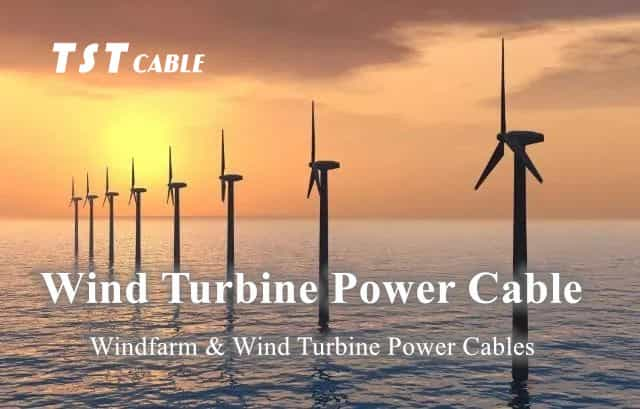Wind farm instrumentation cables are cables specifically designed to connect between instrumentation and power or signal sources as a core component of power equipment for monitoring or controlling power systems and processes. For example, to transmit temperature, pressure or flow measurement data. They can also be used to control valves, thermostats and indicator lights. As a cable specialist for the wind power industry, TST CABLES understands the importance of cables in wind farm equipment.

Wind farm instrumentation cables need to have the following performance advantages:
- Excellent electrical performance, able to provide stable and reliable current and voltage output to ensure the normal operation of power equipment.
- Good heat resistance, power equipment often work in high temperature environments, and instrumentation cables can withstand high temperature environment to ensure the normal operation of the equipment.
- Good waterproof performance, corrosion resistance and low smoke and halogen-free flame retardant properties, can be used in harsh environmental conditions to maintain good results.
- Strong anti-interference ability and signal transmission stability, and can withstand large current and voltage.
- Higher energy efficiency and environmental friendliness to meet the green development requirements of the power industry.
- Need to adapt to the needs of data acquisition, transmission and processing to adapt to and realize the information management of the power industry.
- Fire resistance: in order to prevent fire and other accidents from causing damage to the cable, the cable should have a certain degree of fire resistance.
In summary, wind power power industry instrumentation cables as an important part of the power equipment, with unique features and a wide range of applications.TST CABLES specializes in the research and development and production of instrumentation signal cables for the power industry and other low-smoke halogen-free flame-retardant high-temperature cables, which are widely used in the fields of aviation, aerospace, weaponry, ships, petrochemicals, power generation, rolling stock and so on. In the future, we will continue to innovate and make greater contributions to the development of the industry.
TST CABLES wind farm instrumentation signal cable products recommended:
The products are produced according to Q/TST-DL-001-2010 standard, and also can be produced according to the International Electrotechnical Commission’s recommended standard IEC, British standard, German standard and American standard according to the user’s demand.
1.wind farm Cable structure
There are four layers of protection, sheath, shielding, winding layer, insulation. The role of each layer of protection is introduced separately.
2.wind farm Cable Characteristics
Excellent corrosion resistance, oil resistance, resistance to strong acids, alkalis, etc.; excellent electrical insulation properties, high temperature resistance, high frequency loss is small, does not absorb moisture, insulation resistance; excellent flame retardant, aging resistance, long service life.
3.wind farm Cable applications:
Transmission of analog signals in terms of automation components, mainly temperature sensors, pressure sensors, flow sensors signal transmission. In addition can also be used as a water car room shear pin signal transmission, openness, vibration, pendulum sensor preamplifier to the disk cabinet signal transmission.
TST CABLES instrumentation cables play an important role in the field of power transmission in wind farms to ensure the reliability, safety and performance of the cables, thus guaranteeing the normal operation of wind power generation and the effective transmission of electrical energy.
TST CABLES wind farm cable testing standards and specifications
I. Wind farm cable testing content
TST CABLES wind farm cable testing content includes appearance testing, electrical performance testing, mechanical performance testing and other aspects. The appearance of the test is mainly on the cable insulation, sheath, connectors and other checks to ensure that it is not damaged, aging or other damage. Electrical performance testing is mainly on the cable’s electrical parameters, insulation resistance, dielectric loss, partial discharge and other indicators to ensure that it meets the requirements. Mechanical performance testing is mainly on the cable’s tensile strength, bending radius, durability and other tests to ensure that it is not broken or damaged during long-term use.
Second, wind farm cable testing methods
TST CABLES wind farm cable testing methods mainly include on-site testing and laboratory testing in two ways. On-site testing is usually used portable testing equipment, the electrical and mechanical properties of the cable can be simple and rapid detection. Laboratory testing is required to send the cable to a professional laboratory for testing, the cable’s various performance indicators for comprehensive and detailed testing.
Third, wind farm cable testing standards
TST CABLES wind farm cable testing standards mainly include international standards, industry standards and local standards. Common international standards include IEC, IEEE and other standards. Industry standards include GB/T, DL/T and other standards. Local standards are the relevant standards developed by each province, city or region. Wind power cable testing standards should be selected according to the actual situation, and need to meet the requirements of relevant national laws and regulations.
Fourth, the wind farm cable common problems
1, wind farm cable cable insulation aging, damage and other issues
2, wind farm cable cable copper core connector welding joints off, oxidation and other issues
3, wind farm cables and cables soaked in water leading to strong electric components short circuit or oxidized rust and other issues
TST CABLES wind farm cable is an indispensable and important part of the wind farm, testing the quality and performance of the cable can help to ensure the normal operation and safety of the wind farm. Therefore, practitioners need to familiarize themselves with the standard specifications for wind power cable inspection, master its inspection content, methods and standards, and discover problems and deal with them in time to ensure the normal operation of wind farms.

Also available in:
English

